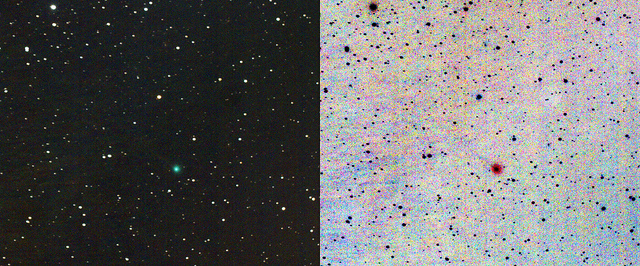[caption id="attachment_134266" align="alignleft" width="580"]
Comet 2P Encke glides through Pisces on February 16th. Image credit and copyright:
Hisayoshi Kato
.[/caption]
Miss out on Comet
45/P Honda-Mrkos-Padadušáková
last month? We'll admit, it was fairly underwhelming in binoculars... but fear not, there are several other binocular comets in the pipeline for 2017.
Maybe you managed to catch sight of periodic Comet 2P Encke in late February after sunset before it disappeared into the Sun's glare. Pronounced (En-Key), the comet actually passes through the field of view of the joint NASA/ESA Solar Heliospheric Observatory's (SOHO) LASCO C3 camera from
March 8thto March 14th
before reemerging in the dawn sky.
I see you... Comet 2P Encke is now in SOHO's LASCO C3 field of view, above Mercury (the bright object) moving in the opposite direction: pic.twitter.com/gcYwv0Sdkp — Dave Dickinson (@Astroguyz)
Northern hemisphere observers have already got a sneak peek at Encke's performance low in the dusk in February as it heads towards perihelion. Now the comet heads southward, as it vaults up into the dawn sky for folks south of latitude 30 degrees north in mid-March. From latitude 30 degrees north, Encke will clear 15 degrees elevation above the southeastern horizon around March 31
st
. Viewers south of the equator will have a much better viewing prospect, as Encke glides southward through Aquarius. When will you first spot it?
[caption id="attachment_134268" align="alignnone" width="580"]
The dawn path of 2P Encke through the first week of April as seen from latitude 30 degrees north. Credit: Starry Night.[/caption]
Also: don't forget to 'spring forward' to Daylight Saving Time this weekend for a majority of North America prior to beginning your dawn comet vigil... Europe and the United Kingdom gets a brief reprieve 'til March 26th.
Her are some upcoming key events for Comet 2P Encke:
Closest to Sun: March 10
th
, with a perihelion of 0.33 AU.
Closest to Earth: March 12
th
, at 0.65 AU distant.
Brightest: Around March 15. Encke is
currently at magnitude +7
, and should top out at magnitude +6, though it'll only be 14 degrees from the Sun on this date.
[caption id="attachment_134267" align="alignnone" width="580"]
The projected light curve for comet 2P Encke. Image credit: Seiichi Yoshida's
*Weekly Information About Bright Comets*
.[/caption]
Next good apparition: 0.4 AU from Earth in 2036.
This is
Encke's 63rd passage
through the solar system since Pierre M
é
chain
linked successive passages of the comet to the same in 1819. Like Edmond Halley, Encke didn't discover the most famous of comets that now bears his name, but instead merely deduced its periodic nature. Halley was 1
st
, and Encke was second (hence the "2" in 2P...) The shortest short period comet, Encke was captured sometime thousands of years ago into its short period orbit, and is destined to burn out one day as it ventures from 4.1 to 0.33 AU from the Sun. Encke is also the source of the annual Taurid meteor shower in November, notable for producing a high rate of fireballs.
[caption id="attachment_134271" align="alignnone" width="580"]
Comet 2P Encke on February 19th. Image credit and copyright:
Cajun Astro
.[/caption]
Comets can be elusive beasties, as all of that precious quoted magnitude is smeared out over an extended surface area. Add on top this the fact that comets are also notorious for often under- and occasionally over-performing expectations. Just look at the 'none more black' albedo of comet 67P
Churumov-Gerasimenko
ch
ronicled by ESA's Rosetta spacecraft: it's a miracle we can see 'em at all. And finally, that low contrast dawn sky can easily hide a faint binocular comet, fading it to invisibility. Start your comet vigil early, sweeping the horizon with binocs. An early start and a clear view are key. The slim waning crescent Moon sits 12 degrees north of Comet Encke on the morning of March 26
th
, and the comet also passes less than 3 degrees from the Helix Nebula (NGC 7293) on (no joke) April Fool's Day April 1
st
.
[caption id="attachment_134269" align="alignnone" width="580"]
The view on the morning of March 26th, 30 minutes before sunrise. Credit: Stellarium.[/caption]
Flashback to one
Encke orbit ago to 2013
and the comet provided a good dawn preshow to that biggest of cosmic let downs, Comet ISON. And although Encke makes its rounds every 3.3 years, orbital geometry assures that we won't get another favorable viewing from Earth until 2036.
[caption id="attachment_134270" align="alignnone" width="580"]
The orbit of 2P Encke. Credit NASA/JPL[/caption]
Speaking of great comets that never were, we juuuust missed having a spectacular comet this past month, when recently discovered long-period
Comet 2017 E1 Borisov
passes just 0.045 AU (!) interior to our orbit. Unfortunately, this occurs five months too early, with the Earth almost exactly at the wrong place in its orbit. Now, if it was only August...
Comet Teaser for 2017
Yeah, the gambler's fallacy would tell us that we're due for the next great comet of the century, for sure. In the meantime, we've still got Comets 41P/Tuttle-Giacobini-Kres
á
k
(late March/April), C/2015 ER61 PanSTARRS (May), and C/2015 V2 Johnson (June) on tap as good binocular comets in 2017.
Be sure to enjoy elusive comet Encke as it flits once more though the dawn skies.
-Read about comets, occultations, eclipses and more for the year, in our new free e-book
*101 Astronomical Events for 2017*
out from Universe Today.
 Universe Today
Universe Today
